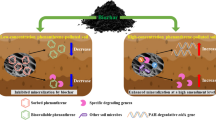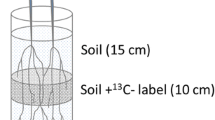Abstract
Purpose
Bioremediation experiments of polycyclic aromatic hydrocarbon (PAHs) using ryegrass (Lolium perenne), a turfgrass in urban landscapes, were carried out aiming to explore the ryegrass-assisted degradation in an actual PAH-contaminated urban soil and the phytotransformation pathways of PAHs within plants.
Methods
Dynamics of plant-assisted degradation of 15 PAHs in pot soils were recorded over 100-day cultivation, and at the end, the accumulation of PAHs in ryegrass was investigated. Ryegrass with phenanthrene exposure was cultured hydroponically to investigate the phytotransformation intermediates using gas chromatography–mass spectrometry and ultra-performance liquid chromatography coupled to high-resolution mass spectrometry.
Results
Overall, dissipation of PAHs in soils exhibited an initial fast and subsequent slow degradation pattern. Eventually, on average, 55.7% and 47.1% of \(\sum {PAHs}\) were removed in the planted and unplanted soils, respectively, with the high-molecular-weight PAHs highly eliminated particularly. Plant growth resulted in 4.8–11.1% more \(\sum {PAHs}\) removed from soil compared to the plant-free controls. The PAHs all exhibited the bioconcentration and translocation factors below 1. The mass balance calculation showed that plant uptake accounted for < 1% of the dissipation increase while plant-promoted microbial biodegradation made the dominant contribution. A total of 7 metabolites were tentatively identified based on which possible transformation pathways were proposed.
Conclusion
The results indicated that ryegrass may act as a metabolic sink for aqueous PAHs while microbes play a dominant role in soil PAH dissipation via biodegradation. The results may pave the path for a scientific, safe, and effective implementation of landscape configuration to ameliorate urban soil pollution.





Similar content being viewed by others
References
Alagic SC, Maluckov BS, Radojicic VB (2015) How can plants manage polycyclic aromatic hydrocarbons? May these effects represent a useful tool for an effective soil remediation? A review. Clean Technol Environ Policy 17:597–614
Alves WS, Manoel EA, Santos NS, Nunes RO, Domiciano GC, Soares MR (2017) Detection of polycyclic aromatic hydrocarbons (PAHs) in Medicago sativa L. by fluorescence microscopy. Micron 95:23–30
Ando D, Fujisawa T, Katagi T (2015) Uptake, translocation, and metabolism of phenols by submerged rooted macrophyte, water milfoil (Myriophyllum elatinoides). J Agric Food Chem 63:5189–5195
Berg G, Smalla K (2009) Plant species and soil type cooperatively shape the structure and function of microbial communities in the rhizosphere. FEMS Microbiol Ecol 68:1–13
Binet P, Portal JM, Leyval C (2000a) Fate of polycyclic aromatic hydrocarbons (PAH) in the rhizosphere and mycorrhizosphere of ryegrass. Plant Soil 227:207–213
Binet P, Portal JM, Leyval C (2000b) Dissipation of 3–6-ring polycyclic aromatic hydrocarbons in the rhizosphere of ryegrass. Soil Biol Biochem 32:2011–2017
Cerniglia CE (1992) Biodegradation of polycyclic aromatic hydrocarbons. Biodegradation 3:351–368
Denef K, Six J, Paustian K, Merckx R (2001a) Importance of macroaggregate dynamics in controlling soil carbon stabilization: short-term effects of physical disturbance induced by dry-wet cycles. Soil Biol Biochem 33:2145–2153
Denef K, Six J, Bossuyt H, Frey SD, Elliott ET, Merckx R, Paustian K (2001b) Influence of dry-wet cycles on the interrelationship between aggregate, particulate organic matter, and microbial community dynamics. Soil Biol Biochem 33:1599–1611
Dupuy J, Leglize P, Vincent Q, Zelko I, Mustin C, Ouvrard S, Sterckeman T (2016) Effect and localization of phenanthrene in maize roots. Chemosphere 149:130–136
Dzantor EK, Chekol T, Vough LR (2000) Feasibility of using forage grasses and legumes for phytoremediation of organic pollutants. J Environ Sci. Health - Toxic/hazard Subst Environ Eng 35:1645–1661
Fang CW, Radosevich M, Fuhrmann JJ (2001) Atrazine and phenanthrene degradation in grass rhizosphere soil. Soil Biol Biochem 33:671–678
Folwell BD, McGenity TJ, Whitby C (2016) Biofilm and planktonic bacterial and fungal communities transforming high-molecular-weight polycyclic aromatic hydrocarbons. Appl Environ Microbiol 82:2288–2299
Fu D, Teng Y, Shen Y, Sun M, Tu C, Luo Y, Li Z, Christie P (2012) Dissipation of polycyclic aromatic hydrocarbons and microbial activity in a field soil planted with perennial ryegrass. Front Environ Sci Eng 6:330–335
Gao Y, Shen Q, Ling W, Ren L (2008a) Uptake of polycyclic aromatic hydrocarbons by Trifolium pretense L. from water in the presence of a nonionic surfactant. Chemosphere 72:636–643
Gao YZ, Zhu LZ (2004) Plant uptake, accumulation and translocation of phenanthrene and pyrene in soils. Chemosphere 55:1169–1178
Gao YZ, Zhang Y, Liu J, Kong HL (2013) Metabolism and subcellular distribution of anthracene in tall fescue (Festuca arundinacea Schreb.). Plant Soil 365:171–182
Gao YZ, Xiong W, Ling WT, Wang H, Ren LL, Yang ZY (2008b) Partitioning of polycyclic aromatic hydrocarbons between plant roots and water. Plant Soil 311:201–209
Ghosal D, Ghosh S, Dutta TK, Ahn Y (2016) Current state of knowledge in microbial degradation of polycyclic aromatic hydrocarbons (PAHs): a review. Front Microbiol 7: 1369–1369
Günther T, Dornberger U, Fritsche W (1996) Effects of ryegrass on biodegradation of hydrocarbons in soil. Chemosphere 33:203–215
Guo MX, Gong ZQ, Miao RH, Rookes J, Cahill D, Zhuang J (2017) Microbial mechanisms controlling the rhizosphere effect of ryegrass on degradation of polycyclic aromatic hydrocarbons in an aged-contaminated agricultural soil. Soil Biol Biochem 113:130–142
Haritash AK, Kaushik CP (2009) Biodegradation aspects of polycyclic aromatic hydrocarbons (PAHs): a review. J Hazard Mater 169:1–15
Huckelhoven R, Schuphan I, Thiede B, Schmidt B (1997) Biotransformation of pyrene by cell cultures of soybean (Glycine max L), wheat (Triticum aestivum L), jimsonweed (Datura stramonium L), and purple foxglove (Digitalis purpurea L). J Agric Food Chem 45:263–269
Iovieno P, Baath E (2008) Effect of drying and rewetting on bacterial growth rates in soil. FEMS Microbiol Ecol 65:400–407
Jansson JK, Hofmockel KS (2020) Soil microbiomes and climate change. Nat Rev Microbiol 18:35–46
Kang FX, Chen DS, Gao YZ, Zhang Y (2010) Distribution of polycyclic aromatic hydrocarbons in subcellular root tissues of ryegrass (Lolium multiflorum Lam.). BMC Plant Biol 10
Kolb M, Harms H (2000) Metabolism of fluoranthene in different plant cell cultures and intact plants. Environ Toxicol Chem 19:1304–1310
Lawal AT (2017) Polycyclic aromatic hydrocarbons. A Review Cogent Environ Sci 3:1
Ma L, Li YH, Yao L, Du HM (2021) Polycyclic aromatic hydrocarbons in soil-turfgrass systems in urban Shanghai: contamination profiles, in situ bioconcentration and potential health risks. J Clean Prod 289
Maliszewska-Kordybach B (1996) Polycyclic aromatic hydrocarbons in agricultural soils in Poland: preliminary proposals for criteria to evaluate the level of soil contamination. Appl Geochem 11:121–127
Martin BC, George SJ, Price CA, Ryan MH, Tibbett M (2014) The role of root exuded low molecular weight organic anions in facilitating petroleum hydrocarbon degradation: current knowledge and future directions. Sci Total Environ 472:642–653
McCutcheon SC, Schnoor JL (2004) Phytoremediation: transformation and control of contaminants, 121. John Wiley & Sons
Meng LA, Qiao M, Arp HPH (2011) Phytoremediation efficiency of a PAH-contaminated industrial soil using ryegrass, white clover, and celery as mono- and mixed cultures. J Soils Sed 11:482–490
Miller MM, Wasik SP, Huang GL, Shiu WY, Mackay D (1985) Relationships between octanol-water partition coefficient and aqueous solubility. Environ Sci Technol 19:522–529
Olson PE, Wong T, Leigh MB, Fletcher JS (2003) Allometric modeling of plant root growth and its application in rhizosphere remediation of soil contaminants. Environ Sci Technol 37:638–643
Olson PE, Castro A, Joern M, DuTeau NM, Pilon-Smits EA, Reardon KF (2007) Comparison of plant families in a greenhouse phytoremediation study on an aged polycyclic aromatic hydrocarbon-contaminated soil. J Environ Qual 36:1461–1469
Olson PE, Castro A, Joern M, DuTeau NM, Pilon-Smits E, Reardon KF (2008) Effects of agronomic practices on phytoremediation of an aged PAH-contaminated soil. J Environ Qual 37:1439–1446
Polder MD, Hulzebos EM, Jager DT (1995) Validation of models on uptake of organic chemicals by plant roots. Environ Toxicol Chem 14:1615–1623
Rao M, Scelza R, Scotti R, Gianfreda L (2010) Role of enzymes in the remediation of polluted environments. J Soil Sci Plant Nutr 10:333–353
Rezek J, Wiesche CID, Mackova M, Zadrazil F, Macek T (2008) The effect of ryegrass (Lolium perenne) on decrease of PAH content in long term contaminated soil. Chemosphere 70:1603–1608
Sandermann H Jr (1994) Higher plant metabolism of xenobiotics: the “green liver” concept. Pharmacogenetics 4:225–241
Schnoor JL, Licht LA, McCutcheon SC, Wolfe NL, Carreira LH (1995) Phytoremediation of organic and nutrient contaminants. Environ Sci Technol 29:318A-323A
Shahsavari E, Aburto-Medina A, Taha M, Ball AS (2016) Phytoremediation of PCBs and PAHs by grasses: a critical perspective. In: Ansari AA, Gill SS, Gill R, Lanza GR, Newman L (eds) Phytoremediation: Management of Environmental Contaminants, vol 4. Springer International Publishing, Cham, pp 3–19
Su YH, Zhu YG (2008) Uptake of selected PAHs from contaminated soils by rice seedlings (Oryza sativa) and influence of rhizosphere on PAH distribution. Environ Pollut 155:359–365
Thiele-Bruhn S, Brümmer GW (2005) Kinetics of polycyclic aromatic hydrocarbon (PAH) degradation in long-term polluted soils during bioremediation. Plant Soil 275:31–42
Thiele S, Brummer GW (2002) Bioformation of polycyclic aromatic hydrocarbons in soil under oxygen deficient conditions. Soil Biol Biochem 34:733–735
Tian ZY, Vila J, Yu MA, Bodnar W, Aitken MD (2018) Tracing the biotransformation of polycyclic aromatic hydrocarbons in contaminated soil using stable isotope-assisted metabolomics. Environ Sci Technol Lett 5:103–109
USEPA EM (1977) Sampling and analysis procedures for screening of industrial effluents for priority pollutants, Method 610, Polynuclear Aromatic Hydrocarbons
Wei R, Ni JZ, Li XY, Chen WF, Yang YS (2017) Dissipation and phytoremediation of polycyclic aromatic hydrocarbons in freshly spiked and long-term field-contaminated soils. Environ Sci Pollut Res 24:7994–8003
Zheng XH, Ding H, Xu XM, Liang BQ, Liu XY, Zhao D, Sun LN (2020) In situ phytoremediation of polycyclic aromatic hydrocarbon-contaminated agricultural greenhouse soil using celery. Environ Technol 42:3329–3337
Zhou XB, Zhou JT, Xiang XM, Cebron A, Beguiristain T, Leyval C (2013) Impact of four plant species and arbuscular mycorrhizal (AM) fungi on polycyclic aromatic hydrocarbon (PAH) dissipation in spiked soil. Pol J Environ Stud 22:1239–1245
Funding
This work was funded by the National Natural Science Foundation of China (grant number: 41907094) and the Shanghai Pujiang Program (grant number: 19PJ1405500).
Author information
Authors and Affiliations
Contributions
Li Ma: conceptualization, methodology, writing—original draft, investigation. Lei Yao: methodology, resources. Yuhong Li: Project administration.
Corresponding author
Ethics declarations
Conflicts of interest
The authors declare no competing interests.
Additional information
Responsible editor: Yanzheng Gao
Publisher's Note
Springer Nature remains neutral with regard to jurisdictional claims in published maps and institutional affiliations.
Supplementary information
Below is the link to the electronic supplementary material.
Rights and permissions
About this article
Cite this article
Ma, L., Yao, L. & Li, Y. Bioremediation of a polycyclic aromatic hydrocarbon–contaminated urban soil: degradation dynamics and phytotransformation pathways. J Soils Sediments 22, 797–808 (2022). https://doi.org/10.1007/s11368-021-03108-5
Received:
Accepted:
Published:
Issue Date:
DOI: https://doi.org/10.1007/s11368-021-03108-5




